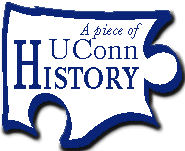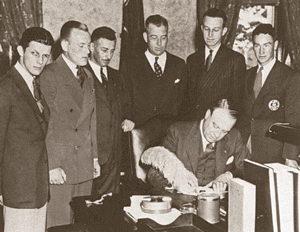
| ||||
|
Many in the University community in 1939 believed that the name change was just accepting reality, that over the years the college had evolved into a university. Yet the change of status had not gone unchallenged.
A letter to the editor of the New York Herald signaled early concerns about the little college in Storrs becoming a state university. The letter, published on April 11, 1897, ended with: "The logic of the school, if encouraged, will fasten upon Connecticut a State University, for which it has no use, and which it cannot afford to maintain." During the next several decades, the issue rose and fell, coming to a fever-pitch in the early 1920s in what became a politically charged public debate in the state's newspapers. Connecticut, and other New England states, had resisted establishing public state universities, counter to the movement in the rest of the country. With so many established private colleges, went the line of reasoning, why spend public money on a competing public institution? Newspaper editorial writers in the state in 1921, for example, questioned the value of teaching English literature, French and German to farmers. In 1925, the General Assembly voted to limit enrollment to 500 students per year, to satisfy fears that CAC would grow into a state university of immense size. (By the 1930s, the measure was ignored, and it was repealed in 1937; enrollment that year exceeded 800 students.) But there would indeed be a state university - and the steps leading in that direction began almost as soon as the ink was dry on the 1925 legislation. Nathan Gatchell, editor-in-chief of the Connecticut Campus, in 1928 began a print campaign to have the word "agricultural" taken out of the college's name, maintaining that "agriculture" no longer represented the type of institution, because the majority of students were taking non-agricultural courses. He also held that the name was a handicap to graduates seeking jobs in other fields. The trustees were not pleased. They demanded that the administration - led at the time by acting president Charles B. Gentry, who later became the first dean of the School of Education - discipline Gatchell and "impose censorship on the Campus." Gentry, however, did neither. The Drama Club of the era did not fare as well with the trustees, who ordered the student group to stop performing as "The Connecticut State College Players." After all parties agreed the name was inaccurate, the students complied. Bertram Wright, the new Campus editor in 1929, carried on the battle, with support from some of the faculty. Shortly after Wilbur Cross was elected governor in 1930, representatives of the college approached him about a change of name. Cross appointed a committee, headed by Ernest W. Butterfield, state education commissioner, to report back to the General Assembly. In the interim, students continued the debate, and it spilled over to state newspapers. Editorials and letters-to-the-editor called for a change of name to "Storrs State College" or "Nathan Hale College," not just Connecticut State. A poll of students in 1931 showed that of 407 who voted, 393 preferred "University of Connecticut," and only 14 favored "Connecticut State College." The committee appointed by Gov. Cross reported early in 1933 that the word "agricultural" was indeed no longer representative of what the college offered in its curriculum and recommended that the name be changed to "Connecticut State College." During a legislative hearing, the descendants of founders Charles and Augustus Storrs made a pitch for the name "Storrs State College," and a representative of Connecticut College for Women argued that "Connecticut State College" would encroach on the private college's name. It was pointed out, however, that the Storrs family's contributions at that time amounted to less than the private contributions from others, not to mention the state's investment over the years, which was then said to total $3,125,000. Legislators also rejected Connecticut College's claim, on the grounds that a private school could not prevent the state from applying its name to its own institution. Legislation changing the name of CAC to CSC was signed by Wilbur Cross on February 25, 1933. Then in 1937, state Rep. Edward D. Seger of Colchester submitted a bill to the legislature titled "An Act to Establish a University in Connecticut." According to Walter Stemmons, the university editor who published a history of the college's first half-century, the bill called for an appropriation of $5 million to buy land, construct buildings, hire a faculty, and provide a broad curriculum of study. That bill was tabled, but Seger reintroduced it early in the 1939 session.
The new version of House Bill #1227 was very brief, simply stating that "The name of the Connecticut State College is changed to The Connecticut State University." That too was changed, and the final bill called for CSC to become The University of Connecticut. Once Seger's bill was reported favorably from the legislature's Education Committee, a response came from Storrs. Although it is presented as a statement from the college, the tone and style of the document strongly suggest that the author was Albert N. Jorgensen, the 39-year-old president of CSC, who had won legislative approval for a major building program for the Storrs campus in the 1937 legislative session. Jorgensen noted that "The State College is in fact a State University and therefore should be a university in name," and also pointed out that CSC was a member of the National Association of State Universities. He pledged that passage of the bill "would not result in any radical change in either policy or procedure," and suggested that the change would "eliminate confusion with Connecticut College for Women." The bill passed both houses of the General Assembly without dissent and was signed into law by Gov. Raymond Baldwin on May 26, effective July 1, 1939. Mark J. Roy Sources: Connecticut Agricultural College, A History, (1931) Walter Stemmons; unpublished manuscript, University of Connecticut 1928 - 1954, Walter Stemmons; Nutmeg Yearbook, 1952. These and other documents and materials about the history of the University are in the collections of the University Archives, Thomas J. Dodd Research Center. |
 t was 60 years ago this July 1 that the college founded in 1881
as the Storrs Agricultural School formally became the University
of Connecticut.
t was 60 years ago this July 1 that the college founded in 1881
as the Storrs Agricultural School formally became the University
of Connecticut. 

